FOUNDATIONS REVEALED COMPETITION ENTRY

Wild Card Prize - A stunning glimpse into the artisan heritage in her culture
Ojibwe Beaded Yoke
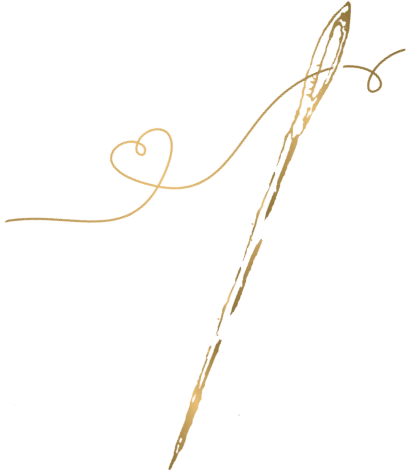
Outline the story …
I was inspired to create this beaded yoke for the character Niska, the matriarch and medicine woman in Joseph Boyden’s 2005 novel "Three Day Road". I read this book over ten years ago, and it still remains one of the most important books for me, an Indigenous woman learning what it means to be a part of the Anishinaabe peoples.
When we first encounter Niska, the year is 1919 and she is waiting for her nephew to return from the front. Niska is one of the last of the Oji-Cree people still living away from the reservations in the heart of the northern Canadian bush. Her connection to her culture and spirituality is unbroken by the loss of her homeland and kin.
Velvet beadwork is perhaps the most iconic form of beadwork to Indigenous peoples across Canada and the northern US. It is deeply connected to the spirituality of the land. The designs in my own yoke were inspired by the traditional designs common to Anishinaabe peoples, in particular a beaded Chippewa collar dated form 1920-1940 from the collection of the National Museum of the American Indian in New York.
The use of metal cones to create jingle collars and jingle dresses emerged in the year 1900, on an Ojibwe reservation. I imagine that Niska would have used this type of jingle garment in her healing. The designs in this collar use plants native to Ontario and I think it captures the spirit of what Niska was trying to preserve.
Outline the construction…
This yoke is made from three layers of material: a cotton velveteen, cotton interfacing, and a cotton poplin. The beaded design was made with coloured glass seed beads, sewn on with a waxed cotton thread using a lazy stitch. Mirrors were attached using E6000 glue – a modern equivalent to animal glue.
I drafted the pattern using my shoulder width and the length that I wanted the yoke to hang down to. Using that pattern, I cut out the velveteen, interfacing, and poplin. I draped the velveteen over a hanger and let it hang for a day before attaching the interfacing layer to prevent stretching or warping once I started to sew the beads.
The design was traced lightly in chalk pen and beads were sewn in groups of 4-5. Traditionally, these items would be sewn in large wooden frames then cut into pattern shapes. However, I did not have access to this type of frame and had to use a small embroidery hoop, being careful not to stretch or warp the velveteen’s pile while sewing.
When the beadwork was finished, the poplin was basted to the velveteen and secured with bias tape. This was my first time sewing bias tape around curves and required some easing to prevent buckling. The jingle cones were attached with a knotted 0.7 cm ribbon and then pinched closed. They were then attached every 1.5 cm with a cross stitch. A brass button and loop closure were sewn into the top of the yoke.

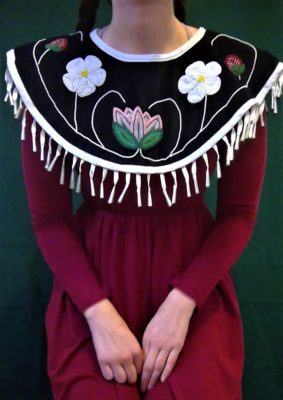

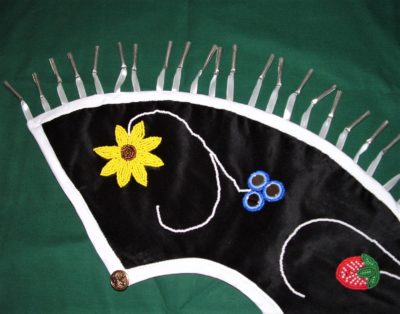
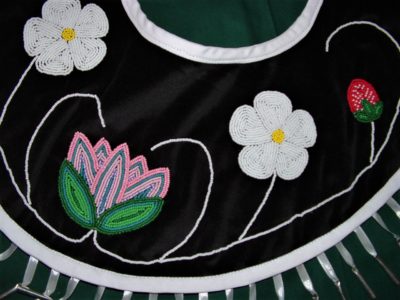
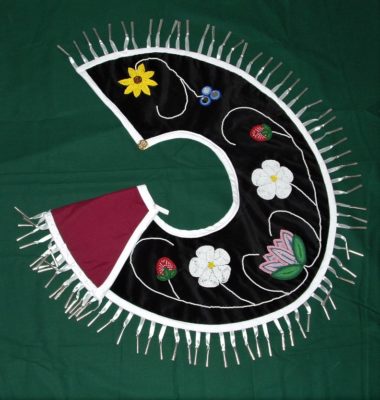
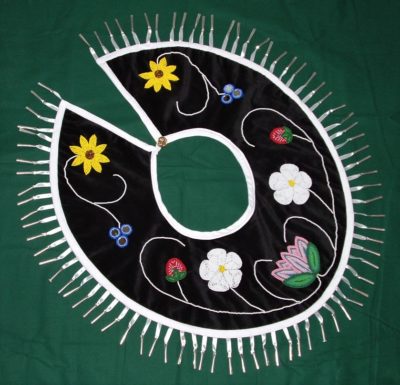
*goggles in amazement*
This is realy amazing😍
Wow!
This is lovely! Your beadwork is extraordinary!
Exquisite. Traditional vintage beauty given its rightful dignity through your skilled hands.
This is absolutely gorgeous!
Great job cousin, proud of you😌. I’m an indigenous woman from the Puyallup Tribe in Washington State. Best of luck with the competition!
Love the design and clear lines. Beautiful!
Stunning work, you should be very proud of this.
Absolutely fantastic beadwork, the design is beautiful. All the thought that was put into this is obvious, and I can only imagine what the little metal cones sound like when you move.
I love this. It’s beautiful, the imagery is so striking and the execution is very elegant.
That is amazing! The symmetry of the design is just beautiful. Congratulations on such good work!
You did not make your jingle cones out of traditional metal findings? The lids of snuff cans. I am glad that you did stay with traditional floral beadwork. I saw Anishinaabe to me that would be Odawa, Saulteaux, Ojibwe (including Mississaugas), Potawatomi, Oji-Cree, and Algonquin. Neat work for your first foray into Native North American traditions. Are you an NBA or just for a study in design?
That is gorgeous! So well done!
That beadwork is amazing!
Absolutely beautiful!
This is truly stunning work. Very very well done 👏
All that beading–superbly done!
Beautiful. and well done.
So beautiful! Excellent work!
Gobsmackingly beautiful. You’ve created a treasure. Your beadwork is lovely.
❤️ So beautiful❤️
So! Much! Beadwork! *jawdrop* And the geometry of it! Just. Wow.
Beautiful! I thought it was beautiful when it seemed like fabric applique. Zooming in to see such lovely, tidy beadwork… wow. Well done! Good luck from Icarus!
This is so beautifully made.
I’m absolutely amazing by this!
This blows my mind away , I think it is beautiful . Congratulations on your entry 🙂
Very beautiful, I love it!
Such a beautiful entry. Your concept and execution are brilliant!
This is gorgeous!! The amount of work you put into it is clear! I’ll have to add that book to my reading list. Thank you for sharing!
This is stunning! I have done beadwork myself and understand it’s real complexity! This is amazing work! Thank you!
Love the intensity of the colours and beadwork. Congratulations on the bias wrangling too.
This is stunning! Well executed and the elegance of each symbol is not lost in a lot of detail. Thank you for sharing this with us.
This is beautiful, and now everyone who sees it will know something they didn’t know before about indigenous cultures. Great work!
Stunning
That’s wonderful! <3 And I have to say.. embroidering is addictive. 😀